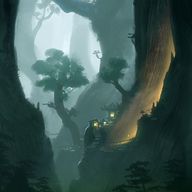Bodue is a temperate forest planet, home of the Haaru.
Bodue is dominated in multiple respects by Mother Lomoi (Boduan)s, a species of enormous and nearly immortal tree. They now comprise a large majority of the planet's biomass. They grow to a height and root-width of about four miles.
Natural History
Main article: Natural History of Bodue
The Boduan Atmospheric Anomaly had major effects on every aspect of the planet. First, it killed off most species of Bodue's plankton. This led to a food chain collapse and the extinction of most aquatic species. It was also a major pressure for species to move to land. Presently, there are few purely aquatic species on Bodue. Second, the particular changes in atmosphere seem to be the root cause of the massive increase in size of Mother Lomoi (Boduan).
The Great Boduan Ice Age was a direct result of the atmospheric event, and led to further mass extinction. Most non-mammalian clades, particularly Arthropods were almost completely wiped out.
The Bull Age refers to the period in Boduan evolution where the trees had not adapted to coexist, uprooting each other and in the process causing catastrophic collapses that created an extremely volatile environment.
The Mother Age is defined in opposition to the previous, and is the result of their adaptation to coexistence. This has led to unprecedented environmental stability.
Biomes
Climate
Regional Variations
Seasonal Variations
Natural Disasters
Main article: Natural Disasters of Bodue
Flora
Main article: Flora of Bodue
Bodue was at one point extremely diverse in terms of plant life - it was a forest planet far before the Boduans arose. However, most other species were outcompeted except those which found a way to survive in the ecological margins, or in some form of symbiosis.
Fauna
Main article: Fauna of Bodue
The fauna of Bodue are extremely diverse but mostly dominated by mammalians. The planet has no analogue to birds, reptiles or insects (see Great Boduan Ice Age). A major ice age, and later the evolution of the Boduans led to a massive number of extinctions and new species on the scale of the Cambrian Explosion.
Most mammalians on Bodue are oviparous, except for some ancient species. The largest mammalian cladistic division is between the hexapodal light-boned climbers, gliders and fliers like the Mantis Hawk and Kuol, versus the more varied heavy-boned species. Digits tend toward claws and prehensility for climbing, with a common default grasping mode akin to those of Earth's Bald Eagle. Those adapted to higher altitudes tend toward long necks to access food.
